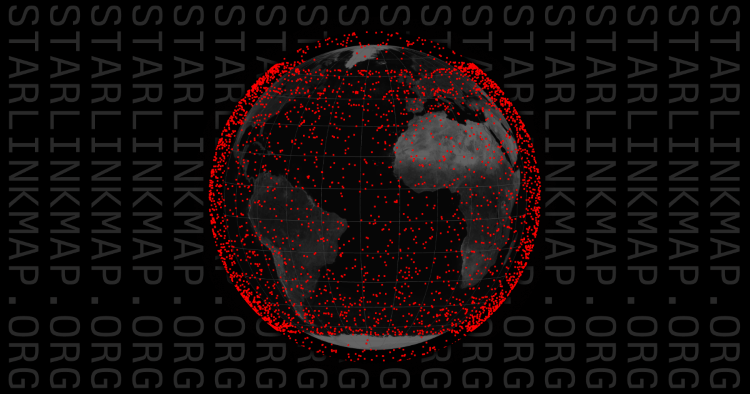In an effort to enhance the educational outreach of their Starlink constellation, there is an interactive global map of their Starlink internet satellites, which provides live coverage of every satellite in orbit around the Earth. This interactive map and information was produced by Will DePue, who is a an OpenAI programmer and openly states he is not affiliated with SpaceX or Starlink. This interactive map comes as SpaceX continues to launch Starlink satellites into orbit on a near-weekly basis with the goal of providing customers around the world with high-speed internet while specifically targeting rural regions of the globe. In 2022, Starlink officially reached all seven continents after Starlink service became available in Antarctica. Additionally, SpaceX announced in 2023 a partnership with T-Mobile for Starlink to provide mobile coverage, as well.
Continue reading “Watch a Real-Time Map of Starlinks Orbiting Earth”A Solution to Space Junk: Satellites Made of Mushrooms?
According to the latest numbers from the ESA’s Space Debris Office (SDO), there are roughly 6,900 artificial satellites in orbit. The situation is going to become exponentially crowded in the coming years, thanks to the many telecommunications, internet, and small satellites that are expected to be launched. This creates all kinds of worries for collision risks and space debris, not to mention environmental concerns.
For this reason, engineers, designers, and satellite manufacturers are looking for ways to redesign their satellites. Enter Max Justice, a cybersecurity expert, former Marine, and “Cyber Farmer” who spent many years working in the space industry. Currently, he is working towards a new type of satellite that is made out of mycelium fibers. This tough, heat-resistant, and environmentally friendly material could trigger a revolution in the booming satellite industry.
Continue reading “A Solution to Space Junk: Satellites Made of Mushrooms?”SpaceX Describes Exactly How They’re Planning to Make Starlink Satellites Less Visible From Earth
In 2015, Elon Musk announced that his company, SpaceX, would be deploying satellites to orbit that would provide high-speed broadband internet access to the entire world. Known as Starlink, SpaceX began deploying this constellation in May of 2019 with the launch of the first 60 satellites. As of April 22nd, a total of 422 satellites have been added to the Starlink constellation, and the response hasn’t been entirely positive.
In addition to fears that we’re adding to the problem of “space junk,” there are also those who’ve expressed concern that Starlink and other constellations could have a negative impact on astronomy. In response, SpaceX recently announced that it will be instituting changes in how the satellites are launched, how they orbit the Earth, and even how reflective they are in order to minimize the impact they have on astronomy.
Continue reading “SpaceX Describes Exactly How They’re Planning to Make Starlink Satellites Less Visible From Earth”Elon Musk says that SpaceX Has no Plans to Spin Off Starlink
Last week, the Satellite 2020 Conference & Exhibition wrapped up after four days of presentations and addresses from some of the leading experts in the telecommunications industry. As advertised, SpaceX founder Elon Musk was on hand to deliver a keynote speech in which he announced that (contrary to earlier statements) Starlink will not be spun off and become its own business enterprise.
Continue reading “Elon Musk says that SpaceX Has no Plans to Spin Off Starlink”Elon Musk Tweets with Starlink. Services Could be Available Next Year.
In January of 2015, Elon Musk shared his vision of creating a constellation of satellites in Low Earth Orbit (LEO) that would provide broadband internet access to the entire planet. Back in May, SpaceX launched the first batch of 60 Starlink satellites to orbit, with plans to send an additional 1,584 to space by 2024 and 2,200 more by 2027.
Naturally, consumers have been wondering when they will be able to avail themselves of this new internet service. As SpaceX Chief Operations Officer Gwynne Shotwell announced on October 22nd, the company should be able to offer broadband access within the US by mid-2020. This came a day after Musk sent the inaugural tweet using Starlink services.
Continue reading “Elon Musk Tweets with Starlink. Services Could be Available Next Year.”SpaceX Files a Request to Launch Another 30,000 Satellites for Starlink, on Top of the 12,000 They’re Already Planning to Launch

SpaceX is really kicking things into high-gear with its Starlink network. The creation of this satellite constellation is central to Elon Musk’s vision of providing high-bandwidth internet access to a global market. Deployment began in earnest back in May with the launch of the first sixty Starlink satellites, with plans to launch an additional 1,584 by 2024 and 2,200 by 2027.
Until now, SpaceX’s long-term goal was to create a constellation of 12,000 satellites at altitudes ranging from 328 km to 580 km (200 to 360 mi) – based on what the FCC has approved so far. But according to recent filings with the International Telecommunication Union (ITU), SpaceX intends to send an additional 30,000 Starlink satellites to Low Earth Orbit (LEO) in the coming years.
Continue reading “SpaceX Files a Request to Launch Another 30,000 Satellites for Starlink, on Top of the 12,000 They’re Already Planning to Launch”SpaceX has Lost Contact With 3 of its Starlink Satellites
Back in May 23rd, 2019, SpaceX launched the first batch of its Starlink constellation, a fleet of satellites that will fulfill Elon Musk’s promise to provide broadband satellite-internet access to the entire planet. The deployment of these sixty satellites was the first in a series of six planned launches that would see around 720 satellites orbiting at an operational altitude of 550 km (340 mi).
Over the course of the past month, SpaceX announced that all sixty of the satellites were responsive, but recently indicated that contact had been lost with three of them. According to a statement issued by a company spokesperson on June 28th, these three satellites pose no danger as they will deorbit “passively” and burn up in the atmosphere.
Continue reading “SpaceX has Lost Contact With 3 of its Starlink Satellites”SpaceX just launched 60 satellites for its Starlink Constellation. Internet service providers should be very worried.
On Thursday, May 23rd, 2019, SpaceX launched the first batch of their Starlink satellites to orbit. The launch took place at 10:30 pm EDT (07:30 pm PDT) from Space Launch Complex 40 (SLC-40) at Cape Canaveral on the Florida coast. With this delivery, SpaceX founder Elon Musk is making good on his promise to begin providing global broadband internet access to the entire world, a goal that has become somewhat challenging in recent years.
Continue reading “SpaceX just launched 60 satellites for its Starlink Constellation. Internet service providers should be very worried.”Starlink’s Satellites Will be Orbiting at a Much Lower Altitude, Reducing the Risks of Space Junk
Among Elon Musk’s many plans for the future, one of the more ambitious has been the creation of a constellation of satellites that will offer broadband internet access to the entire world. Known as “Starlink”, the company’s long-term plan is to deploy over 12,000 internet satellites to Low Earth Orbit (LEO) by the mid-2020s.
Despite criticism and dismissal, Musk and SpaceX have taken some major steps in recent years to get the ball rolling on this proposal. And according to a recently-released official statement from the company, mass production is well underway and the first batch of operational satellites are already in Florida awaiting their scheduled May 2019 launch.
Continue reading “Starlink’s Satellites Will be Orbiting at a Much Lower Altitude, Reducing the Risks of Space Junk”SpaceX Gives More Details on how their Starlink Internet Service Will Work. Less Satellites, Lower Orbit, Shorter Transmission times, Shorter Lifespans
For years, Elon Musk has talked about his plans to provide broadband internet access to the world using a constellation of satellites. Known as Starlink, this constellation was originally going to of nearly 12,000 low-cost satellites providing a terabit internet service. The first batch of these satellites is scheduled to launch in June of 2019, with the full constellation being deployed by the mid-2020s.
While the bare bones of this plan have been public knowledge for some time, Musk and the company he founded to reinvigorate space exploration have been somewhat scant on the details. But thanks to a simulation created by Prof. Mark Handley of University College London, the world may finally get an idea of what Starlink might look like.






